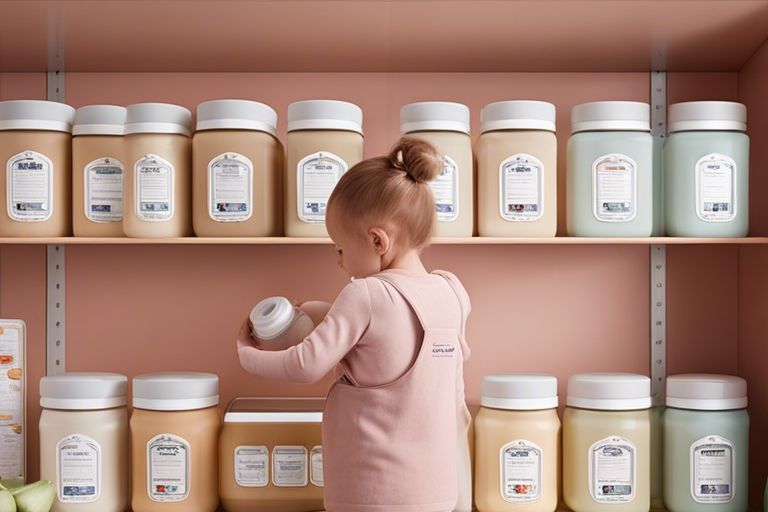tips, tricks and guides for parenthood
Formula feeding can be a convenient and nutritious option for babies, but it's crucial to follow best practices when preparing and storing formula. The proper handling of formula is necessary to ensure your baby's health and safety. From selecting the right type of formula to correctly measuring and storing it, there are important steps to consider. Let's explore some top tips for prepping and storing formula to keep your little one happy and healthy.

Even before your little one arrives, it's necessary to think about the type of formula you plan to use. Each baby is different, so it's important to consult with your healthcare provider to determine whether your baby requires a standard cow's milk formula, a soy-based formula, or a specialised formula for any specific dietary needs.
The key to successful bottle-feeding lies in having the right equipment at hand. The necessarys include feeding bottles, teats, a bottle brush for cleaning, a steriliser to ensure hygiene, and formula milk. Having a dedicated area for preparing feeds and storing equipment can help streamline the process and make feeding time more enjoyable for both you and your baby.
| Step | Instructions |
| 1 | Wash your hands thoroughly and ensure all equipment is sterilised. |
| 2 | Boil fresh water and leave it to cool for no longer than 30 minutes. |
| 3 | Follow the manufacturer's instructions to measure and add the correct amount of formula powder. |
| 4 | Securely fasten the lid and shake the bottle until the formula is fully dissolved. |
| 5 | Check the temperature before feeding to your baby. |
| Tip | Details |
| 1 | Use a bottle warmer or place the bottle in warm water to reach body temperature. |
| 2 | Avoid microwaving formula as it can create hot spots that could burn your baby's mouth. |
Step-by-Step - When preparing a bottle of formula, following each step precisely is vital in ensuring your baby receives the correct nutrition. From sterilising equipment to checking the final temperature, every step plays a crucial role. Don't skip any steps and always double-check your measurements for accuracy.
On occasions when you need to store unopened formula, it's important to keep it in a cool, dry place away from direct sunlight. Make sure the packaging is intact and not damaged. Always check the expiration date before use to ensure the formula is still safe for your little one.
Prepared bottles need to be stored properly to maintain their freshness. To prevent bacterial growth and contamination, store prepared formula in the refrigerator for no longer than 24 hours. It's necessary to cover the bottle with a clean cap or lid to keep it sealed and maintain hygiene.
After preparing your baby's formula following the Infant formula: 7 steps to prepare it safely guidelines, it's time to feed your little one. Here are some crucials for a smooth feeding experience:
Essentials: When feeding your baby, ensure they are in an upright position to prevent choking or overfeeding. It's important to burp your baby frequently during and after feeding to release any swallowed air, reducing the chances of discomfort and spit-ups.
Time to keep those feeding crucials clean and safe for your baby's use. To prevent any harmful bacteria contamination, ensure you wash bottles, teats, and caps thoroughly with hot, soapy water after each use. Sterilise them using a bottle steriliser or by boiling them in water for at least 5 minutes. This routine will keep your baby's feeding equipment germ-free and safe for their delicate tummy.
To wrap up, prepping and storing formula correctly is crucial for bottle-feeding your baby. By following best practices such as preparing only one bottle at a time, using cooled boiled water, storing formula in a clean environment, and discarding leftover formula after a feed, you can ensure your baby's health and safety. Remember to always follow the manufacturer's instructions on the formula packaging and consult with your healthcare provider if you have any concerns. Bottle-feeding can be a special bonding time with your little one, so by taking care with how you prepare and store their formula, you are setting the stage for happy and healthy feeding times together.
A: Prepping and storing formula correctly ensures that your baby receives safe and nutritious milk, helping them grow and thrive.
A: Wash your hands, sterilise the bottle and teats, boil water and let it cool slightly, pour the correct amount of water into the bottle, add the appropriate amount of formula, and shake well to mix.
A: It is safest to prepare formula just before a feed. If you need to make it in advance, store it in the fridge for no more than 24 hours. Do not leave it at room temperature for more than 2 hours.
A: Store prepared formula in the back of the fridge where it's coldest. Ensure it is covered and kept separate from other food items to prevent contamination.
A: Yes, you can gently reheat the formula in a bottle warmer or by placing the bottle in warm water. Do not use a microwave as it can create hot spots in the milk. Discard any leftover formula after the feed.